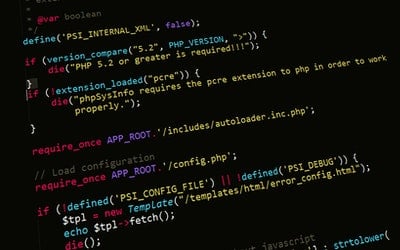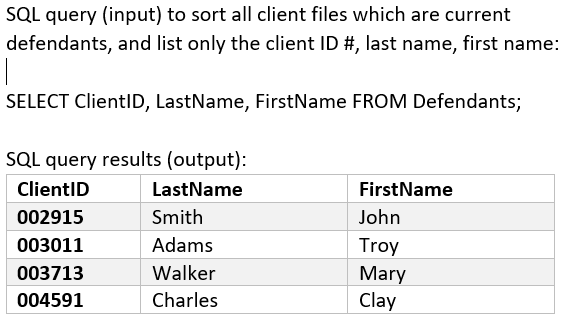
How is Artificial Intelligence used in the Legal Industry?
Table of Content-
- Law Practice Management Software
- LPMS and CMS Similarities
- SQL Defined
- Automation
- AI Solution
- An AI Example
Law Practice Management Software
Wikipedia defines LPMS as software designed to manage a law firm’s case and client records, billing and bookkeeping, schedules and appointments, deadlines, computer files.
Essentially an LPMS system combines a contract management system (CMS), which is a massive group of software combined into one business solution, a calendar, and a QuickBooks-like software for accounting and billing clients.
Ingredient #1: Contract Management Systems
Contract managements systems (CMS) manage contracts of all industry types. Just like an LPMS, a CMS contains a document repository. In recent years, these document repositories are stored on the cloud. This allows many people to view, edit, redline, approve, sign, etc. each document simultaneously or on their own time. Changes made to a document are stored automatically for all viewers to see immediately. Sometimes a CMS is known as a document management system or a content management system.
LPMS and CMS Similarities
Clients of a law firm use special client portals of an LPMS to receive documents confidentially. Clients can also use the eSignature function to sign contracts digitally within the portal, which keeps the document and signatures secure through encryption.
LPMS and CMS also include a customer relationship management system (CRM). CRM is like the phone book feature on a smart phone. It keeps records of client names, addresses, phone numbers, notes, etc. These client records can be added to notification alerts within a LPMS or CMS.
Ingredient #2: Artificial Intelligence
CMS uses artificial intelligence (AI) to automate processes. AI is a part of modern CMS software. LPMS also incorporates AI in modern software. AI is used to sort data in moments (usually less than 1 second) via a set of instructions to a computer, which are set in motion through a variety of methods. Some AI is initiated in a form, such as when a website adds your email to a mailing list when you enter your email address in the “get more info” form, or in the “contact us” page of a website.
CMS software. LPMS also incorporates AI in modern software. AI is used to sort data in moments (usually less than 1 second) via a set of instructions to a computer, which are set in motion through a variety of methods. Some AI is initiated in a form, such as when a website adds your email to a mailing list when you enter your email address in the “get more info” form, or in the “contact us” page of a website.
SQL Defined
SQL manages database content. Databases store records of various datum. For example, a law firm will keep all data pertaining to all clients in one or more database. A law firm likely has a master list (in table format) of all clients, with subset lists such as defendants, plaintiffs, corporations, etc. Managing SQL is typically done manually. Data can enter a database either manually or via programming code.
AI replaces some of the manual versions of retrieving database data subsets, also known as SQL queries. For example, in a manual CMS or LPMS system, a person uses the same form-like setup in the “get more info” email example above to perform a query. A query is an answer (output) to a question (input). Queries retrieve data from a database using the SQL language.
SQL statements are entered into a portal for a person to communicate to the processor of a computer. The processor translates the commands into a language that the computer can use to perform the task desired by the person. A person enters criteria (input) into the SQL query (the portal), and the results of the query are produced (listed) on the console (output).

An SQL query is coded (written) by a programmer to retrieve a sample of data from a much larger database, or from similarities among multiple databases (relational database). The sample of data is then sorted and used to accomplish a task, in this example, expiry dates for contracts.
SQL Example
Imagine that a database that houses 1,000 contracts has data titles for each column. Perhaps there is a law partner that orders a paralegal to provide the partner with a list of all current defendant clients. The paralegal could either do this manually, which could take hours or days. Or the paralegal could do an SQL query and get the results in about 1 second. The example below uses SQL to list only current clients which are defendants listed in the database table entitled, “Defendants”. "SELECT" is known as a keyword in SQL, which is one of the possible first command words communicated to the computer processor for each SQL query. Every SQL statement ends with a semicolon (;).

Automation
CMS and LPMS take the concept of AI a step further. Internal to the CMS and LPMS programs, there are various data structures such as a stack, hashing, binary search tree, or others used to sort data and produce results that are usable (readable) by a person. Programmers for CMS and LPMS code common list (output) concepts into the software itself. Such output is produced daily, and then sent in an email format or listed on the “My Tasks” portion of an organization's intranet. Software developers refer to this as “automation”.
Common tasks (lists/output) for lawyers and paralegals include:
- Current clients
- Clients with court dates approaching

- Clients with contracts about to expire
- Clients with billing issues
- Contract creation deadlines
- Opposing legal team in court cases
- Judges' names
LPMS includes many of these tasks as standard options, available with toggle switches in the settings of the software. Some LPMS systems offer the ability of a software admin to create customized tasks.
AI Solution
AI operates by commands given to a computer. These commands are sometimes the same commands daily. When commands become daily commands, computer programmers identify these tasks (outputs) to create a separate code base (a smaller subset of a program within a much larger program). The software world refers to this process as AI.
Basically, AI sorts data in a CMS and LPMS on a periodic basis that is usually each midnight. The time is midnight because that is when dates change. For example, a court date is deemed to be ten days away starting at midnight, not at an arbitrary other time of day. When the frequency of the same command (like the SQL query example) occurs at a pre-set number of times, then the internal computer code algorithm changes to customize the user experience.
An AI Example
AI works in LPMS software just like how a smartphone will auto-populate the full words “September” and "Separate" after the user types “Sep” into a text message. In the LPMS, AI will start adding data outputs that might be needed based upon a manual command. For example, if an LPMS user requests output in the form of court dates in 30 days, and also in 10 days, AI will change the code used by the LPMS software to add alerts sent daily to that individual user that reflect court dates in 30 days and also in 10 days.
Summary
AI use in LPMS continues to add features as AI evolves. Tasks that were once a timesaver to perform manually using SQL queries are now being automated by AI software. AI software in LPMS and CMS alike are timesavers for users. This is especially critical because even as the number of clients in a law firm increases the number of hours in a day will always be set at 24.
Dive into a CMS demo.
Written by Dock 365
Our experts have compiled in-depth guides on legal jargon, fundamental contract procedures, and Dock 365 tips and tricks to help you streamline the contracting process from draft to signature and beyond.
Reviewed by Naveen K P
Book a Live demo
Schedule a live demo of Dock 365's Contract Management Software instantly.

